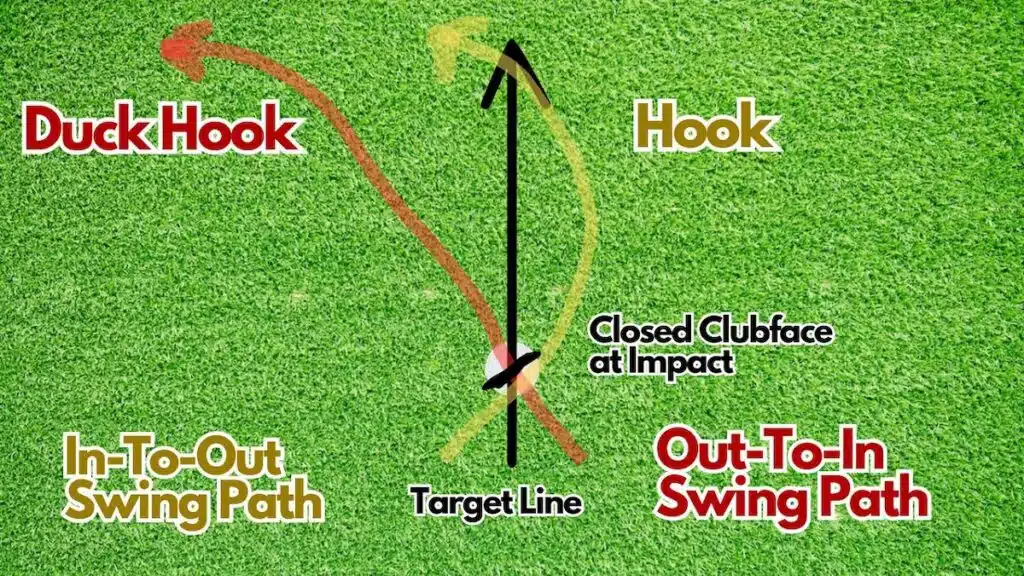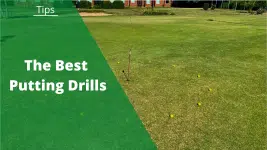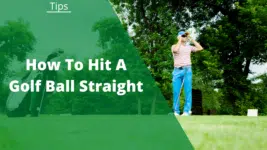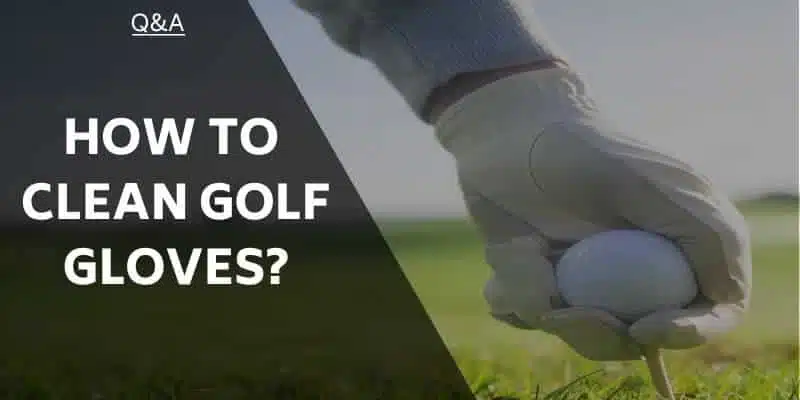A golf duck hook shot sees the ball fly low off the clubface before viciously curving to the left for right-handers. Naturally, the ball flies to the right side of the hole if you are left-handed.
The reduced energy transfer and sidespin, coupled with ball speed drop-off, see your ball travel further sideways than forwards. This results in losing distance, accuracy, and consistency on full shots.
Read on because if you don’t understand what causes a duck hook and how to stop it, you may never reach your potential.
After reading this guide, you will possess the diagnosis and cure of this soul-destroying shot for greater accuracy off the tee and on approach. I will teach you to reduce grip pressure, keep your clubface square to your swing path, and rotate through impact to enjoy straighter shots and increased distance.
What Causes A Duck Hook?
A duck hook or snap hook golf shot is caused by a closed clubface at the point of impact.
A strong grip, incorrect shoulder alignment, excess wrist flexion, and an incorrect kinematic sequence are all possible causes for shutting your clubface closed at contact.
Keep reading to learn how these factors cause your ball to duck hook to identify where you are going wrong.
Strong Grip
My grip is the first factor I inspect when I start duck-hooking the ball because it is usually too strong.
A strong grip is impacted by your left or right hand or both. In my case, I tend to strengthen my right or bottom hand when swinging a driver, prompting me to snap the face shut at impact.
When my bottom hand holds the club too tightly, I can see 3 to 4 knuckles on my right hand, and my palm points to my abdomen. If I keep my grip in this position and only hold the club with my right hand, I notice how closed the clubface is.
Operating with a strong top hand has the same effect. It encourages a closed clubface. I know my left hand is holding the club too tightly when I can see 3 to 4 knuckles, as golf coach Brian Fitzgerald explains below.
Shoulders Offline
Shoulder alignment is the second factor I address when identifying the root cause of my duck hook. My shoulders should point parallel to the target line. However, I occasionally notice my shoulders aiming further left of the target than usual.
This sets me up for starting my ball left of the target, and if I close my clubface marginally at impact, the ball will start left and keep hooking.
Excess Wrist Flexion
I never thought deeply about wrist angles until a few months ago when I tried the HackMotion wrist sensor analyzer. I thought it was interesting that every time I duck-hooked a shot, I produced excessive wrist flex into contact.
I am no physics student, but I wanted to understand how this worked. So, I held out my hands in front of me and flexed my wrists, pushing my fingers downwards. I kept the pose, then turned my palm to face the target before noticing that my palm was even close to the target.
It made sense that when I flexed my wrists into impact, I closed the clubface excessively and risked hooking my driver and approach shots.
Incorrect Kinematic Sequence
The Kinematic Sequence is the optimal chain of events occurring in the swing to maximize speed, power, and accuracy.
Here’s the Kinematic sequence:
- Hip rotation kicks off the sequence
- Followed by your shoulders turning
- These components generate the momentum for your hands, arms, and golf club to follow
I am prone to breaking the sequence and producing duck hook driver shots in my quest for maximizing tee box yardage. I tend to rush my transition from the top of the swing, minimizing hip rotation and shoulder turn, forcing me to rely on my arms.
When my arms take over, my hands and the clubface reach the ball with limited hip rotation or shoulder turn. The loss of clubface control sees my hands turn over through contact, closing the clubface to snap hook my shot.
How Do You Stop Hitting Duck Hooks?
Now that you know what causes a snap hook, this section provides the blueprint to eradicate snap hooks from your repertoire. Keep reading to learn how to induce a neutral grip, square shoulder alignment, controlled wrist flexion, and seamless kinematic sequencing.
Neutral Grip
A neutral strength grip improves your ability to keep the clubface square to your swing path at impact. I grab my golf club with my top hand and place the clubface behind the golf ball. I then adjust the position of my hand until the clubface is square to the target, and I can only see 2 knuckles.
Next, I place my lower hand on the club, which, in my case, is my right hand. I slot the club between the middle joints of my fingers, and I alter the position of my hand until I can see no more than 1 or 2 knuckles on my right hand.
At this point, the club feels comfortable in my hand, I have reduced my grip pressure, and I am promoting a square clubface at contact.
Square Shoulder Alignment
Set yourself up for a successful shot by keeping your feet and shoulders parallel to the target line at address. I recommend getting a friend to place a golf club across your shoulders to highlight where your shoulders are aiming.
I suggest recording your setup and reviewing video footage to see where you are aiming if you do not have a buddy on hand. Keeping your shoulders parallel to the target line positions you to produce a neutral swing path to square the clubface at impact, starting the ball on line.
Seamless Kinematic Sequence
Hips, shoulders, hands. Ensure your downswing follows this order to enhance power, clubhead speed, and clubface control. Initiate hip rotation when your club reaches the top of your swing. The force of your hip rotation propels your shoulders to turn towards your target, lagging the golf club behind.
Following this sequence keeps the clubface on path to generate rapid speed and maximize energy transfer. This helps you preserve ball speed and lower side spin and increase launch for a long, straight golf shot.
Read More: 6 Telltale Signs You Need A Stiffer Shaft
Wrist Flex Prior To Impact
Slightly flexing my wrists prior to impact helps me shallow the shaft and marginally close my clubface to combat slice shots. I appreciate my control over my clubface when the club shaft shallows before impact. However, excess flex into contact prompts my hands to turn over and the clubface to close excessively.
Determining how much and when your wrist flexes during the swing with the naked eye is challenging. That is why I use a training tool like the HackMotion wrist sensor.
Shorten Your Backswing
When you look at how to fix a duck hook with the driver, many coaches and scholars suggest that shortening your backswing causes duck hooks. While I cannot speak to their experiences, I have enjoyed more success with a shorter backswing.
I find I enjoy superior control over the clubface on the downswing, and I find it easier to square the face. In the past, I would overswing my golf clubs, sending my club off plane at the top, and never able to recover. The results were a mix of hooks and slices.
Since shortening my swing, I have slowed my tempo and transition from the top to account for flex and the length of my driver. I do not generate the yardage of days gone by, but I spend more time on the fairway than ever.
Read More: What Driver Loft Should I Use?
Drills To Stop Snap Hooks
I have used numerous drills to combat snap hooks in my 30 years on the links, but I find 4 more effective than the others. The section below explains how to conduct the stepping drill, turn and release, greenside bunker shot drill, and the counting drill.
1. Stepping Drill
I picked up the Stepping Drill from the golf doctor Brian Fitzgerald, and it is designed to produce the optimal kinematic sequencing. I position my clubhead 1 foot behind the ball and place my feet together.
Next, I commence my backswing and pause for 1 to 2 seconds at the top of the swing before stepping forward with my front forward. The forward step creates the hip rotation I need to start my downswing, and the momentum prompts my shoulders to turn and the club head to follow.
Executing this drill effectively sees the hips lead, followed by the shoulders, and then your hands. This encourages you to generate rapid clubhead speed and power while allowing the club to fall into place and square up at contact.
You will feel awkward on the first few shots and likely produce several mishits. However, by my tenth shot, I was striking the ball consistently and enjoying straighter results.
Bunker Shot Drill
My high school coach enjoyed the bunker shot drill to focus on keeping the follow-through and sending the ball straight. He would start me off with a greenside bunker shot 10 to 20 yards from the cup. The shorter swing and smooth rhythm simplified my clubface control.
I would hit 10 of these shots and attempt to keep my forearms straight and hold the follow-through. Once my coach was satisfied with my results, we moved to hitting 30-yard pitch shots from the fairway but repeating my follow-through procedure from the greenside bunker.
I swung softly and kept my forearms extended as I worked to hold the follow-through. After 30 yards, I moved on to 50, then 75, 100, 125, and eventually, 150 yards. The aim was to replicate holding the follow-through on short, medium, and long shots to avoid turning the wrists over through impact and snap-hooking the ball.
Counting Drill
The Counting Drill helps me develop a consistent tempo and prevents me from overthinking a shot. I start with a short iron or wedge and stand 3 to 4 feet from the ball. I start counting out aloud as I address the ball and keep counting until impact.
In my case, I reach the count of 6 by the time my clubface makes contact with my golf ball. The first 2 counts see my feet reach their address position before placing the club behind the ball on 3.
When I reach 4, my clubhead commences the backswing and hits the top of the swing on the count 5. The final count represents my downswing and strike. By counting, I stop overthinking the mechanics of my swing as I do what feels natural to me, leading to less stress and more consistent strikes.
Final Thoughts
The duck hook golf shots I have hit in my career always stemmed from 4 core problems. A strong grip was the predominant culprit, followed by an incorrect kinematic sequence. My third issue was increasing my wrist flex into impact, which forced the clubface closed and sent my ball curving to the left.
Thankfully, a duck hook is an easy fix and does not require thousands of dollars of coaching. Induce a neutral grip to encourage a square clubface at contact and align your shoulders parallel to the target line. Commence your downswing by rotating your hips, then turning your shoulders to create lag and greater clubface control.
I suggest bookmarking this guide so that you can refer back to the Stepping, Bunker Shot, and Counting drills to improve shot accuracy. Once you are striking straighter shots, I recommend working on increasing distance and learning how to hit your driver consistently.
Matt has played golf since he was 4 years old and has written over 150 articles at GolfSpan since 2021. Matt specializes in product reviews using his postgraduate degree in Sports Marketing from Johan Cruyff Institute. Matt has a handicap index of 10.8 and currently plays weekly at Pilar Golf Course near his home in Buenos Aires, Argentina. He also loves his Callaway Odyssey Exo Rossie putter and likes a pepper steak pie with curry gravy at the turn. You can connect with him on LinkedIn.
- Best score: 70
- Favorite club: Callaway Odyssey Exo Rossie
- Favorite ball: Srixon Q-Star Tour
- Favorite food at the turn: Pepper steak pie with curry gravy









